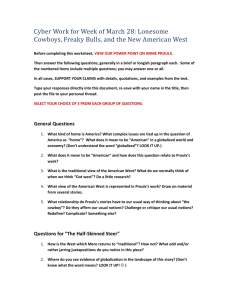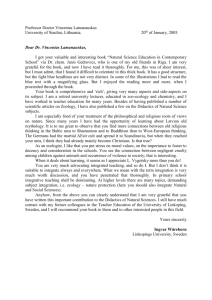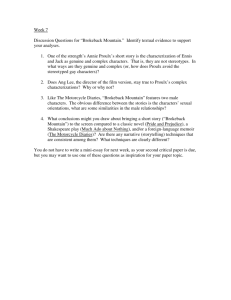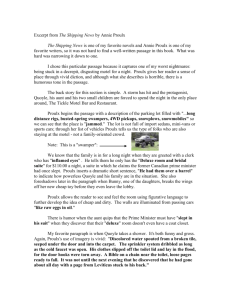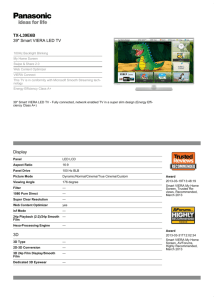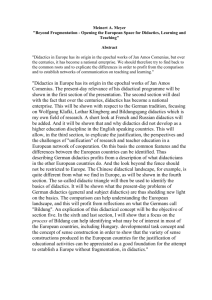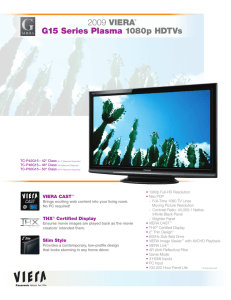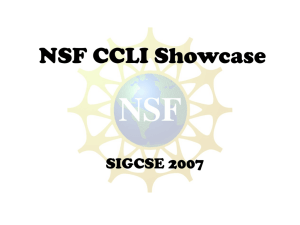What are the didactical principles for teaching computer science
advertisement
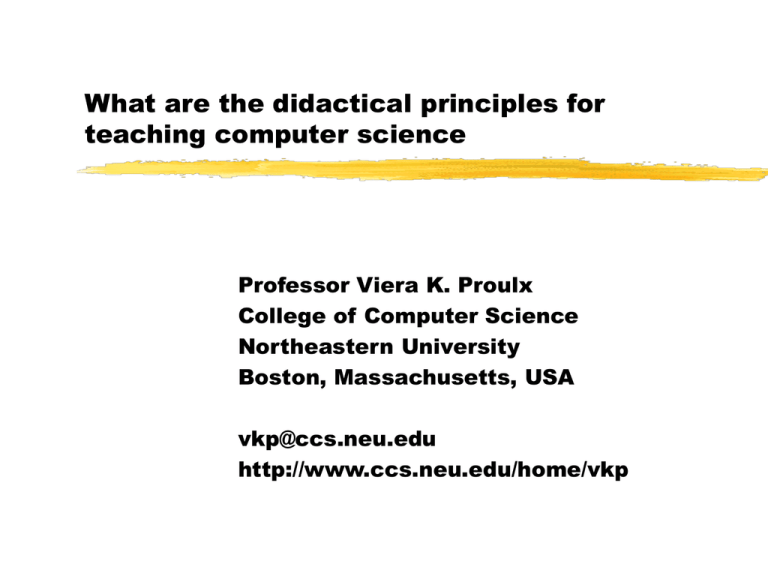
What are the didactical principles for teaching computer science Professor Viera K. Proulx College of Computer Science Northeastern University Boston, Massachusetts, USA vkp@ccs.neu.edu http://www.ccs.neu.edu/home/vkp Outline Why teach computer science/informatics What are the key ideas What are the key didactical principles Using technology to teach computer science Teaching computer science without technology Concluding remarks Acknowledgements Didactics for Computer Science >><< Viera K. Proulx >><< May 1999 Why teach computer science/informatics Recent report by the National Research Council, USA defined: Fluency in Information Technology contemporary skills use of computer and applications foundational concepts mostly informatics intellectual capabilities abstract thinking and reasoning skills http://www2.nas.edu/cstbweb/ Didactics for Computer Science >><< Viera K. Proulx >><< May 1999 Why teach computer science/informatics Contemporary skills (NRC report) setting up a personal computer using basic operating system features using a word processor, spreadsheet, database using graphics package connecting to a network and using Internet to find information using computer to communicate with others using instructional materials to learn how to use new applications or features Didactics for Computer Science >><< Viera K. Proulx >><< May 1999 Why teach computer science/informatics Intellectual Capabilities (NRC report) engage in sustained reasoning manage complexity test a solution manage problems in faulty solutions organize and navigate information structures and evaluate information collaborate; communicate to other audiences expect the unexpected anticipate changing technologies think about information technology abstractly Didactics for Computer Science >><< Viera K. Proulx >><< May 1999 Why teach computer science/informatics Foundational Concepts (NRC report) computers: program, interpretation, CPU, memory, I/O information systems: hardware, software, interfaces, people… networks: physical structure, protocols, bandwidth, standards digital representation of information: text, images, sound, video modeling and abstraction: validity, limitations, how it works algorithmic thinking and programming universality: every computer works the same way!!! limitations: growth rate, tractability, decidability, accuracy societal impact of information and information technology Didactics for Computer Science >><< Viera K. Proulx >><< May 1999 What are the key didactical principles Understand what are the key concepts you are trying to teach Make examples interesting and relevant Provide projects that focus on the concept Use graphics and illustrations to model the concept Present patterns in design and programs Support collaboration and interaction Set the stage for further exploration Didactics for Computer Science >><< Viera K. Proulx >><< May 1999 Using Technology to teach computer science Programs that generate graphics as main output motivation and visual debugging illustration of concepts Animations that illustrate the key concepts to support lectures to provide environment for experimentation Modeling real uses of computers Web sites with supporting material Excel as a modeling and exploration tool (ask Erich Neuwirth…) Didactics for Computer Science >><< Viera K. Proulx >><< May 1999 Programs that generate graphics: scaled drawings Didactics for Computer Science >><< Viera K. Proulx >><< May 1999 Programs that generate graphics: animated loops Didactics for Computer Science >><< Viera K. Proulx >><< May 1999 Programs that generate graphics: nested loop patterns Didactics for Computer Science >><< Viera K. Proulx >><< May 1999 Graphics for feedback and motivation: maze search Didactics for Computer Science >><< Viera K. Proulx >><< May 1999 Graphics for feedback and motivation: function plotting and sorting Didactics for Computer Science >><< Viera K. Proulx >><< May 1999 Mini applications: piano keyboard, MiniPaint Didactics for Computer Science >><< Viera K. Proulx >><< May 1999 Modeling real world computer science: cryptography (Ceasar’s shift) Didactics for Computer Science >><< Viera K. Proulx >><< May 1999 Modeling real world computer science: Mars planetary images real data lot of data mixed text, numeric, and pixel data image enhancement additional topics Didactics for Computer Science >><< Viera K. Proulx >><< May 1999 Modeling real world computer science: Mars planetary images Didactics for Computer Science >><< Viera K. Proulx >><< May 1999 Modeling real world computer science: morphing line drawings Didactics for Computer Science >><< Viera K. Proulx >><< May 1999 Modeling real world computer science: morphing images Didactics for Computer Science >><< Viera K. Proulx >><< May 1999 Modeling real world computer science: recursive fractal grammars recursive fractal grammars (L-systems) impressive use of recursion example of the need for extensive computational power seeing order of growth in ‘real life’ design issues for display (scaling) need for recomputation, good design power of algorithm generate complex drawings from only a few lines of grammar definition Didactics for Computer Science >><< Viera K. Proulx >><< May 1999 Modeling real world computer science: recursive fractal grammars recursive fractal grammars (L-systems) Example: The Sierpinski Gasket: angle = 60° S -> R L -> R+L+R R -> L-R-L FASS Curves (space-filling, self-avoiding, simple, and self-similar) Example: Hexagonal Gosper Curve: angle = 60° S -> L L -> L+R++R-L--LL-R+ R -> -L+RR++R+L--L-R Didactics for Computer Science >><< Viera K. Proulx >><< May 1999 Modeling real world computer science: recursive fractal grammars: Sierpinski gasket, dragon Didactics for Computer Science >><< Viera K. Proulx >><< May 1999 Modeling real world computer science: recursive fractal grammars: tree Bracketed OL-systems angle = 20° S -> F F -> F[+F]F[-F][F] N=6 Didactics for Computer Science >><< Viera K. Proulx >><< May 1999 Modeling real world computer science: traffic simulation Didactics for Computer Science >><< Viera K. Proulx >><< May 1999 Using technology to teach algorithms Animated demonstration to present concept in a lecture for student to explore on her own to compare several algorithms and their properties Timing analysis programs to conduct experiments to learn about algorithm complexity to learn to design and evaluate experiments Didactics for Computer Science >><< Viera K. Proulx >><< May 1999 Using technology to teach algorithms: sorting Insertion sort Didactics for Computer Science >><< Viera K. Proulx >><< May 1999 Using technology to teach algorithms: sorting Quicksort Didactics for Computer Science >><< Viera K. Proulx >><< May 1999 Using technology to teach algorithms: binary trees Expression tree: Didactics for Computer Science >><< Viera K. Proulx >><< May 1999 Using technology to teach algorithms: binary trees Heap (priority queue): Didactics for Computer Science >><< Viera K. Proulx >><< May 1999 Using technology to teach algorithms: graph algorithms: breadth first search Didactics for Computer Science >><< Viera K. Proulx >><< May 1999 What are the key didactical principles Understand what are the key concepts you are trying to teach #Make examples interesting and relevant Provide projects that focus on the concept #Use graphics and illustrations to model the concept Present patterns in design and programs Support collaboration and interaction #Set the stage for further exploration Didactics for Computer Science >><< Viera K. Proulx >><< May 1999 What are the key didactical principles #Understand what are the key concepts you are trying to teach many input prompts and input statements make code messy • solution: filtered input: – X = RequestInt(“Next number:”, 0); when animating algorithms, make sure focus is on algorithm Provide projects that focus on the concept design the solution first: • make students work on key parts • supply the framework make your code a model of good practice Didactics for Computer Science >><< Viera K. Proulx >><< May 1999 What are the key didactical principles Present patterns in design and programs programming patterns: loop design patterns decision patterns algorithmic patterns do for all and collect cumulative result greedy method - do the easiest case first divide and conquer Didactics for Computer Science >><< Viera K. Proulx >><< May 1999 What are the key didactical principles Present patterns in design and programs design and object patterns: scaling change in the frame of reference objects that represent a state function objects that generate values migrating objects that belong to several collections over time collection objects • of other objects • of references to objects traversal objects (iterators) Didactics for Computer Science >><< Viera K. Proulx >><< May 1999 Present patterns in design and programs Hospital Emergency Room Simulation patient arrival: random number, severity code, treatment time discrete probability distribution function object generates next value for a given probability waiting room: priority queue beds: available versus in-use design choices how to handle the free list patient object: migrating object = referenced statistics: where is data collected, design of the experiments meaning and validity of results Didactics for Computer Science >><< Viera K. Proulx >><< May 1999 What are the key didactical principles Support collaboration and interaction group work exploration of animations hands-on illustrations “food for thought” questions Didactics for Computer Science >><< Viera K. Proulx >><< May 1999 Support interaction Towers of Hanoi: hand simulate to deduce the pattern estimate and verify the expected number of moves when will the world end - exponential growth (rice) Didactics for Computer Science >><< Viera K. Proulx >><< May 1999 Support interaction Binary cards: tttt tttt tttt tttt 1 tt tt tt tt 0 tt tt 1 tt 1 t 0 Didactics for Computer Science >><< Viera K. Proulx >><< May 1999 = 21 Support interaction Binary story: I was born in year 110 1100 1010 in Bonn I became a professional musician at the age of 1011 I lived in Vienna since 111 0000 0010 I wrote my first symphony in 111 0000 1000 The third symphonyEroica was written in 111 0000 1100 I died in 111 0010 0011 My name is: ??????? Didactics for Computer Science >><< Viera K. Proulx >><< May 1999 Support interaction Binary clock: Didactics for Computer Science >><< Viera K. Proulx >><< May 1999 The network game Compare your address 1 0 0 1 with address on the message 1 1 0 1 Mark with X all places where the addresses are the same, X and copy the address of the message into the other places 0 X Didactics for Computer Science >><< Viera K. Proulx >><< May 1999 X X 1 The network game Select a color for one of the positions that do not have X Mark the selected position with X and send the message along the wire of that color For example, for the message address X 1 0 X select the second position Didactics for Computer Science mark >><< theViera new address as X X K. Proulx >><< May 1999 0 X The network game If you receive a message, select next color and send it. Messages with addresses X X X X are for you. Read them and reply to the sender. Didactics for Computer Science >><< Viera K. Proulx >><< May 1999 Which concepts did we cover: Foundational Concepts (NRC report) computers: program, interpretation, CPU, memory, I/O information systems: hardware, software, interfaces, people… networks: physical structure, protocols, bandwidth, standards digital representation of information: text, images, sound, video modeling and abstraction: validity, limitations, how it works algorithmic thinking and programming universality: every computer works the same way!!! limitations: growth rate, tractability, decidability, accuracy societal impact of information and information technology Didactics for Computer Science >><< Viera K. Proulx >><< May 1999 Which capabilities did we cover: Intellectual Capabilities (NRC report) engage in sustained reasoning manage complexity test a solution manage problems in faulty solutions organize and navigate information structures and evaluate information collaborate; communicate to other audiences expect the unexpected anticipate changing technologies think about information technology abstractly Didactics for Computer Science >><< Viera K. Proulx >><< May 1999 Conclusion Computer science provides foundation for abstract thinking and reasoning The key ideas help understand the technology and adapt to the change The key didactical principles: experiential learning Use technology, engage students without technology Explore the breadth of computer science applications Didactics for Computer Science >><< Viera K. Proulx >><< May 1999 Acknowledgements Collaborators: Richard Rasala and Harriet Fell Support form the NSF Foundation DUE ILI-LLD 9650552 Support from MicroSoft Corporation Inspiration and suggestions: Erich Neuwirth and my family… http://www2.nas.edu/cstbweb/ http://www.acm.org/education/hscur/ http://www.ccs.neu.edu/home/vkp/ Didactics for Computer Science >><< Viera K. Proulx >><< May 1999
